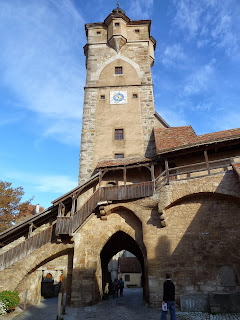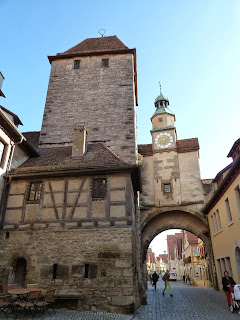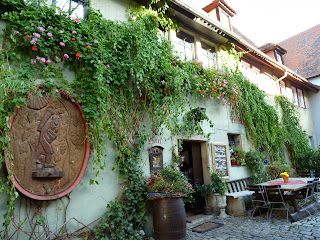We stayed at Hotel Klosterstuble, which had plenty of medieval personality and charm. There are squeaky staircases and no lift, but a wonderful breakfast and good service were provided. When we checked in, the lady helping us gave up her parking place so that we could park there with no fees.
We caught our first glimpse of the town as we walked down the street to a restaurant which was recommended by our hotel staff. It was located in another hotel nearby, and the food was delicious. I enjoyed the thick homemade noodles topped with cheese, slices of pork tenderloin, and smothered with a rich mushroom gravy. Bob had steak in a horseradish flavored sauce with potatoes and cranberry relish. These were suggested by our waitress as dishes typical of the area.
With a map in hand, we started out the next morning to walk the medieval city limits. If we had a little more time, I would have visited the Medieval Crime Museum to see all those gruesome instruments of torture and methods of execution that were used at the time, but we needed to drive another two hours north to catch our return flight to Seoul from Frankfurt that afternoon. Rothenburg is the home of the "schneeball" (or snowball in English), a German pastry which we actually first discovered here in Seoul last Christmas. It is also the home of Kathe Wohlfahrt Christmas shops which are found on every street in town. This is where we purchased our German souvenir, a tri-level Christmas "volcano" featuring a nativity scene - similar to the one shown in the center back of the store window display. Small candles are lit at the base causing the propellers at the top to turn and rotate the scene below.
Although the Hohenstaufen Castle no longer exists, the impressive outer gate remains. Notice the mask with a "mouth" through which the defenders poured hot tar onto their attackers. A beautiful view of the Tauber Valley below can be seen from the castle gardens. The castle was destroyed by an earthquake in 1356.
The massive stone walls surrounding the city were built in 1200 and are fortified with 42 towers. The four main entrance gates to the village are each unique and equally impressive.
The town has a similar feel to Colmar, France, but the streets are wider and the city walls and gates more impressive. Bob liked Rothenburg more, probably because it does have a bit more masculine medieval style. The next photos showcase the sights inside the walls of the city. Don't overlook the cute characters on stilts!
The Plonlein (Little Square) with the Siebers Tower (dating back to 1385) in the background, is one of the world's most popular photos opportunities. Of course, we had to infuse ourselves into that historic place as well!



























































